
Gymnocalycium ritterianum Photo by: Valentino Vallicelli
it has attractive stems and freely produces nice satiny white or pink flowers with rosy throats. This plant is still rare in collections, but, like many of its genus, it is easy to cultivate.
Origin and Habitat: Gymnocalycium ritterianumSN|21423]]SN|21423]] is endemic to Argentina, where it is found in La Rioja. Eeven though the species range small (extent of occurrence is approximately 700 km2) , it is abundant and there are no major threats.
Altitude range: 1,500 to 2,200 metres above sea level.
Habitat and Ecology: The species grows in chaco forest and high-altitude grasslands on alluvial fan and slope hill sides together with Trichocereus huaschaSN|8746]]SN|18495]], and Trichocereus terscheckiiSN|18495]]SN|8746]].
Synonyms:
See all synonyms of Gymnocalycium ritterianum
Description: Gymnocalycium ritterianumSN|21423]]SN|21423]] is a very variable small cactus, usually solitary to occasionally clustering. It has attractive discoid stems and freely-produces satiny white flowers with rosy throats. The "ritterianum" found in cultivation are often so dissimilar that hardly seem the same species.
Derivation of specific name: This member of the cactaceae family was given the name 'ritterianum' by Rausch. Rausch and Ritter are two explorers who played major roles in cataloging the South American cactus flora. With this species, one commemorates the other.
Stem: Flattened, discoidal 3-5 cm tall, 8-11 cm in diameter, clear grey-green, that tinges reddish in full sun.
Ribs: 10-12, with tranverse furrows, divided in more or less pronounced humped, chin-like tubercles.
Spines: 7-9, up to 2,5 cm long, white, yellow or pink/brown, spreading or curved against the plants body, one directed downward , others to the sides
Central spine: None, or sometimes one, straight, rigid, curving backward.
Flowers: Near the apex, up to 6,5 cm long and 7,7 cm in diameter, usually satiny white with rosy to violet throats, but also pure white, pink or red.
Blooming season: Flowers appear recurrently from April to autumn.
Fruits: Pear shaped, bluish.
Bibliography: Major refernces and further lectures
1) Hunt, D., Taylor, N. and Charles, G. (compilers and editors). "The New Cactus Lexicon". dh Books, Milborne Port, UK. 2006.
2) Demaio, P., Perea, M. & Trevisson, M. 2013. Gymnocalycium ritterianum. The IUCN Red List of Threatened Species 2013: e.T152831A683842. http://dx.doi.org/10.2305/IUCN.UK.2013-1.RLTS.T152831A683842.en. Downloaded on 23 July 2016.
3) Edward Anderson “The Cactus family” Timber Press, Incorporated, 2001
4) ISI 2005-3 Gymnocalycium ritterianum Rausch “International Succulent Introductions 2005 - Plant Introductions of the Huntington Botanical Gardens” Published in the Cactus and Succulent Journal Vol. 77 (2), March - April, 2005
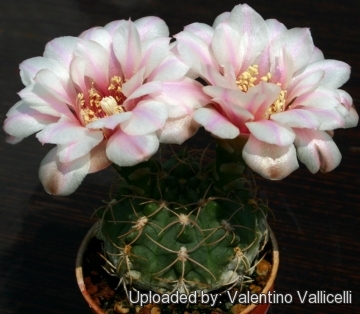 Gymnocalycium ritterianum Photo by: Valentino Vallicelli
Gymnocalycium ritterianum Photo by: Valentino Vallicelli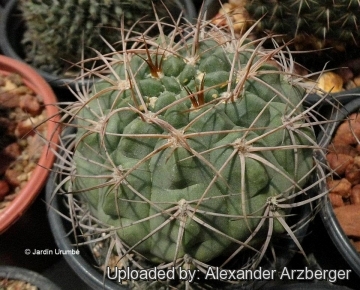 Gymnocalycium ritterianum Photo by: Alexander Arzberger
Gymnocalycium ritterianum Photo by: Alexander Arzberger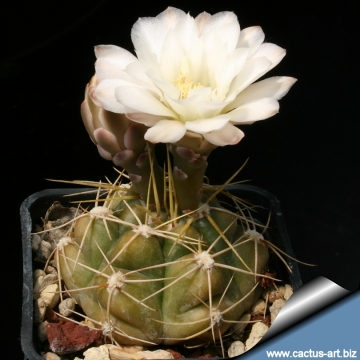 Gymnocalycium ritterianum Photo by: Cactus Art
Gymnocalycium ritterianum Photo by: Cactus Art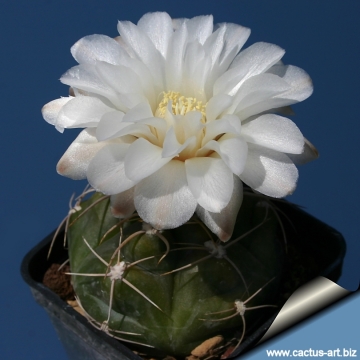 Gymnocalycium ritterianum Photo by: Cactus Art
Gymnocalycium ritterianum Photo by: Cactus Art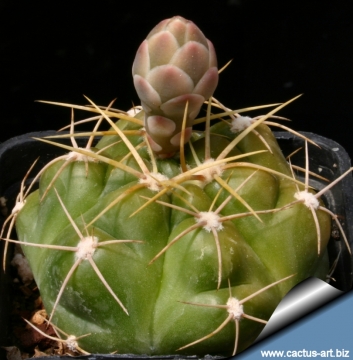 Gymnocalycium ritterianum Photo by: Cactus Art
Gymnocalycium ritterianum Photo by: Cactus Art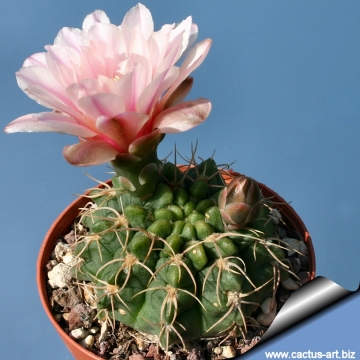 Gymnocalycium ritterianum Photo by: Cactus Art
Gymnocalycium ritterianum Photo by: Cactus Art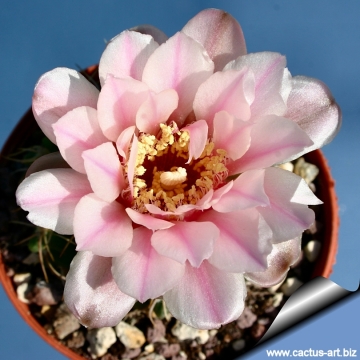 Gymnocalycium ritterianum Photo by: Cactus Art
Gymnocalycium ritterianum Photo by: Cactus Art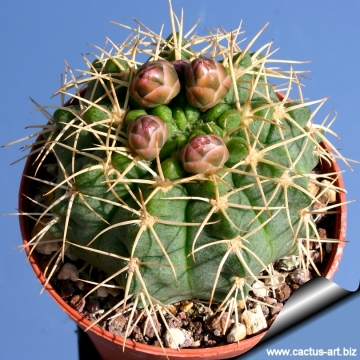 Gymnocalycium ritterianum Photo by: Cactus Art
Gymnocalycium ritterianum Photo by: Cactus ArtCultivation and Propagation: Gymnocalycium ritterianumSN|21423]]SN|21423]] is still uncommon in collections, but, like many of its genus, it is a summer grower species that is easily grown. Water regularly in summer (but do not overwater ) Keep this plant almost dry in winter at a minimum temperature of 0°C, prefer relatively rich substrate and low pH compost (if possible not limestone) otherwise growth will stop altogether. Feed with a high potassium fertilizer in summer. It is quite frost resistant if kept dry (hardy to -5° C) This plant needs plenty of space for its roots, repotting should be done every other year or when the it has outgrown its pot. This species is particularly easy and accommodating, seldom suffer of cryptogamic diseases.
Sun Exposure: Light shade. It may tolerate bright situations but is likely to suffer from sun scorch or stunted growth if over exposed to direct sunlight during the hottest part of the day in summer.
Propagation: Direct sow after last frost. (seldom produces offsets). Seed Collecting: Permit fruit to ripen. Fruit must be significantly overripe before harvesting seed; clean and dry seeds



















